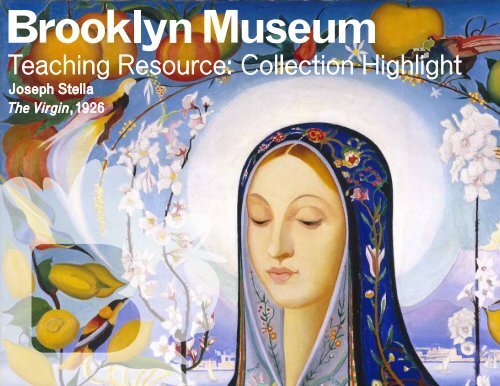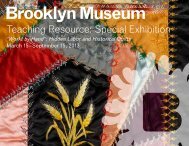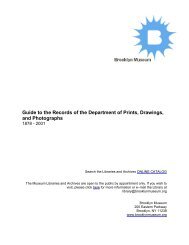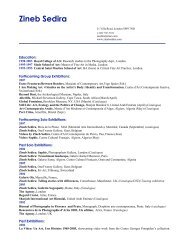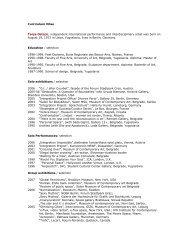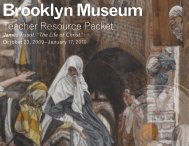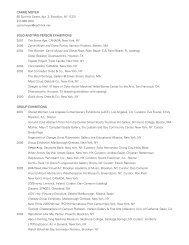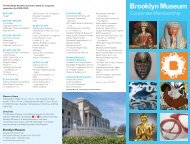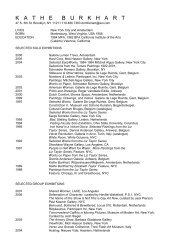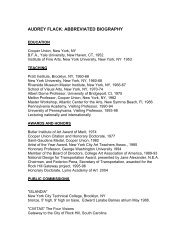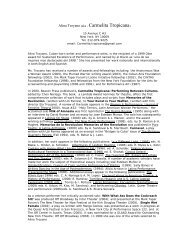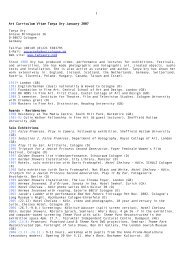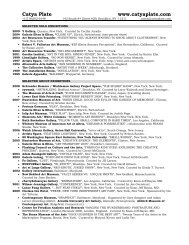Joseph Stella, "The Virgin" - Brooklyn Museum
Joseph Stella, "The Virgin" - Brooklyn Museum
Joseph Stella, "The Virgin" - Brooklyn Museum
You also want an ePaper? Increase the reach of your titles
YUMPU automatically turns print PDFs into web optimized ePapers that Google loves.
<strong>Joseph</strong> <strong>Stella</strong><br />
(American, born Italy,<br />
1877–1946)<br />
<strong>The</strong> Virgin, 1926<br />
Oil on canvas, 39 11/ 16 x 38 3/ 4 in. (100.8 x 98.4 cm).<br />
<strong>Brooklyn</strong> <strong>Museum</strong>, Gift of Adolph Lewisohn, 28.207<br />
Description of the Artwork<br />
<strong>The</strong> central figure is a woman wearing a long, blue, hooded veil<br />
that cascades over her shoulders to the base of the composition. A<br />
white halo frames her head from behind. Her face is turned slightly<br />
to the side. She has smooth, luminous skin, and her eyes are cast<br />
gently downward. Her head and long, slender neck are enveloped by<br />
a pale purple robe punctuated by a brilliant red flower at the base of<br />
her throat. Her open palms rest gently on her chest. A dense array<br />
of flowers decorates the veil and robe, while leafy green stems and<br />
delicate buds meander along the contours of her hands and fingers.<br />
A canopy of vibrantly colored birds, fruits, and flowers curves above<br />
and around the figure. In the background sailboats glide across the<br />
water near the shores of a distant city.<br />
Background Information<br />
<strong>The</strong> artist <strong>Joseph</strong> <strong>Stella</strong> immigrated to the United States from Italy<br />
when he was eighteen years old. While this painting uses the vibrant<br />
palette and high contrast characteristic of his New York scenes,<br />
the balanced composition and religious subject (the Virgin Mary)<br />
recall early Italian Renaissance paintings.
Questions for Viewing<br />
What area of the painting is your eye drawn to first? Why?<br />
Use your body to recreate the figure’s pose and facial expression.<br />
What do you notice? What might these details tell us about this<br />
person?<br />
An attribute is an object associated with a figure that is meant to<br />
help identify or represent that person. What attributes can you find<br />
in this portrait? What more do they tell us about this woman?<br />
Describe the setting. What kind of place might this be?<br />
This painting is titled <strong>The</strong> Virgin. It depicts the Virgin Mary, who is<br />
identified in Christianity and in Islam as the mother of Jesus through<br />
divine intervention. What similarities can you find between this<br />
painting and other images of the Virgin Mary? What differences<br />
do you notice?<br />
Activity<br />
Divide a sheet of paper into two columns. Label one column<br />
“I See” and the other, “I Think.” Look closely at the painting. Record<br />
observations that are factual in the column labeled “I See.” Record<br />
observations based on opinion and inference in the column “I Think.”<br />
Share your inferences with a partner, using visual evidence to<br />
support your ideas.<br />
Resources<br />
www.brooklynmuseum.org/opencollection/onview/<br />
<strong>The</strong> <strong>Brooklyn</strong> <strong>Museum</strong>’s online collection database, featuring a search<br />
function that indicates artworks currently on view and their locations.<br />
www.brooklynmuseum.org/education/educators/teacher_resources.php<br />
This webpage offers links to free web interactives and Teaching<br />
Resources (PDFs) supporting K–12 instruction.<br />
This text was written by Claire Moore, with assistance from School Programs<br />
Manager Alexa Fairchild and Curator of European Art Rich Aste.


